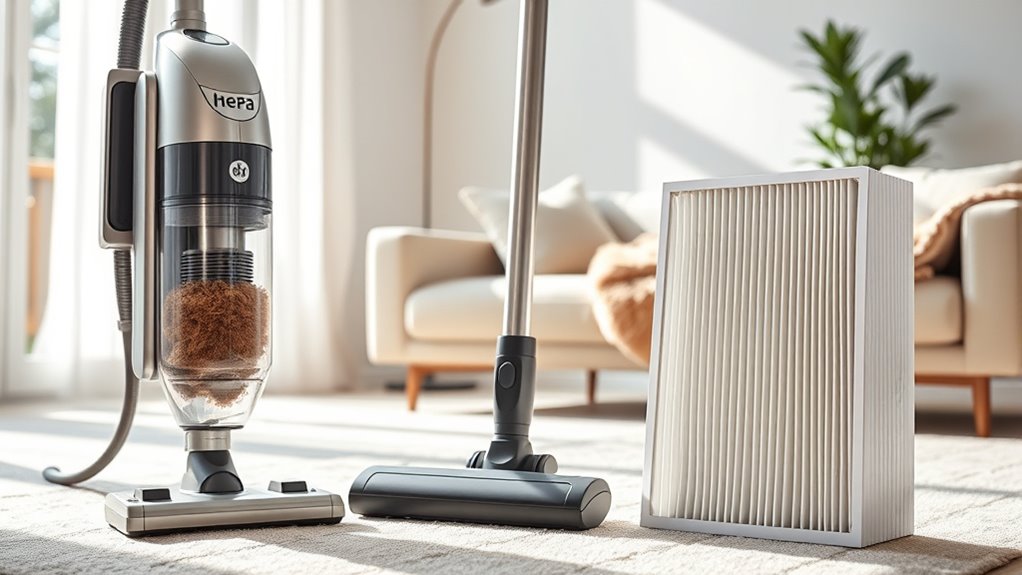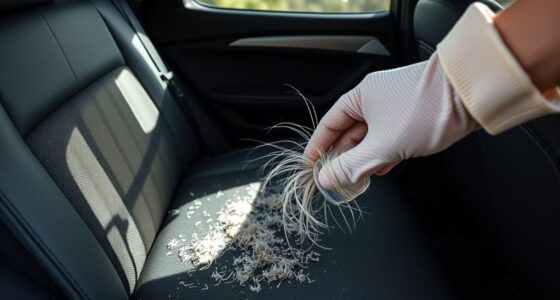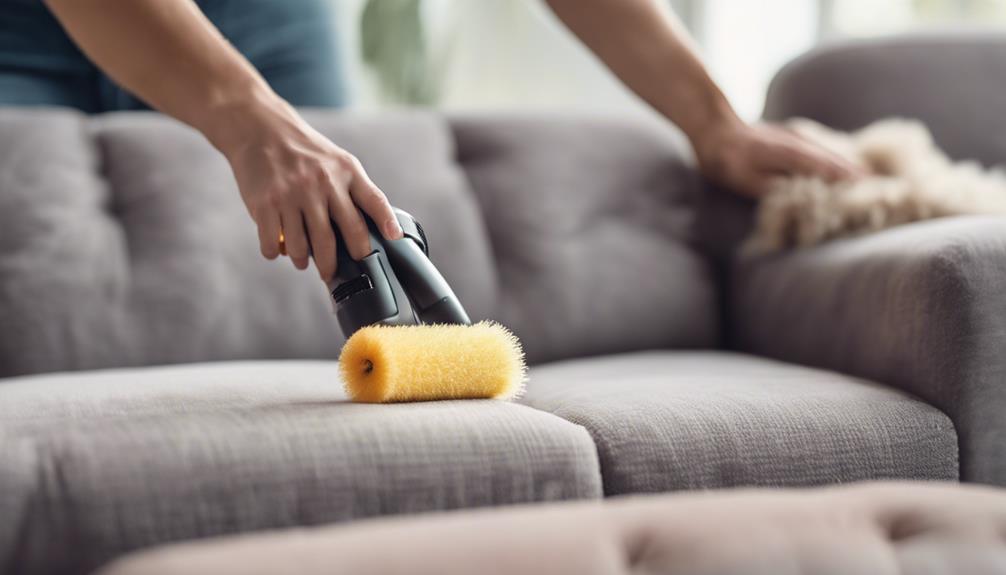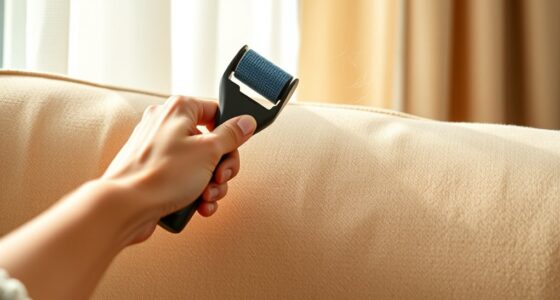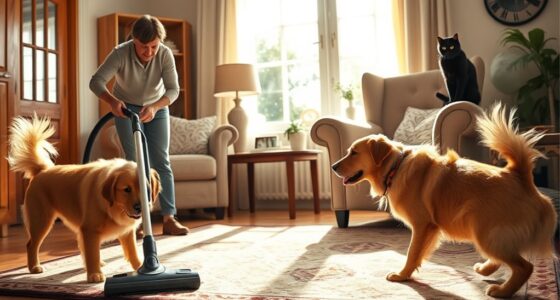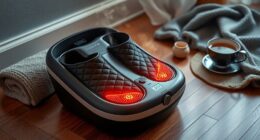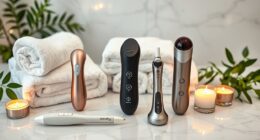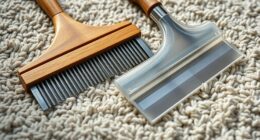To manage pet dander allergies effectively, use HEPA vacuums regularly to eliminate trapped allergens from carpets, furniture, and curtains. Make sure to change or clean filters in your vacuum and air purifiers as recommended, so they work efficiently. Frequent cleaning and good ventilation help keep dander levels low indoors. By maintaining your equipment and staying consistent with cleaning routines, you can breathe easier. Keep exploring for more tips to achieve a healthier, allergen-free environment.
Key Takeaways
- Use HEPA vacuums regularly to effectively trap pet dander deep within carpets and upholstery.
- Maintain and replace HEPA filters in air purifiers to ensure optimal removal of airborne pet allergens.
- Vacuum carpets and pet bedding 2-3 times weekly to reduce allergen buildup and improve indoor air quality.
- Combine vacuuming with regular pet grooming and bedding cleaning to minimize dander shedding.
- Ensure proper ventilation and dust-free devices to disperse allergens and maintain a healthier indoor environment.
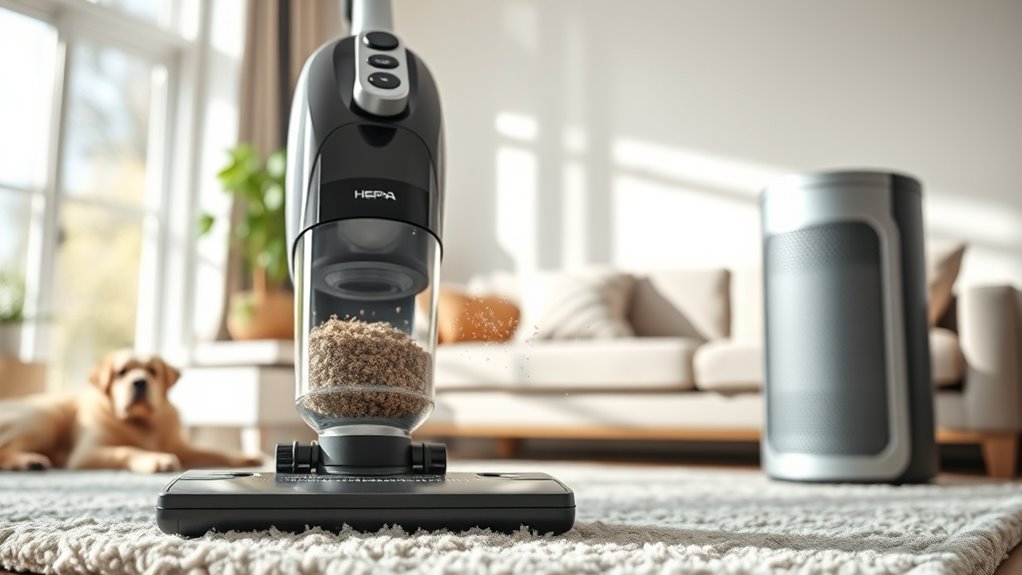
If you’re allergic to pet dander, living with a furry friend can feel challenging, but managing your symptoms is possible. One of the most effective ways to reduce airborne allergens is by using HEPA vacuums and filters. These devices are designed to trap tiny particles, including pet dander, dust mites, and pollen, preventing them from recirculating in your living space. However, simply owning a HEPA vacuum isn’t enough; regular maintenance is vital. Air purifier maintenance, for instance, involves changing or cleaning filters as recommended by the manufacturer. Neglecting this step diminishes the purifier’s ability to capture allergens, rendering it less effective. When you stay consistent with filter changes, you guarantee that your air remains cleaner and your allergy symptoms stay under control.
Regular filter changes ensure your air purifier stays effective in controlling pet dander and allergy symptoms.
Along with air purifier upkeep, focusing on carpet cleaning techniques makes a notable difference. Carpets tend to trap pet dander deep within their fibers, which can continually aggravate allergies if not properly cleaned. Using a HEPA vacuum with strong suction and a sealed system can help remove these allergens effectively. For best results, vacuum carpets frequently—at least two to three times a week—and ensure you cover all areas thoroughly. Consider employing carpet cleaning techniques like hot water extraction, which can loosen and remove embedded dander and dirt. Regular professional carpet cleaning can also help maintain a healthier environment, especially if you or your pet spend a lot of time on the carpeted surfaces. Additionally, choosing the right vacuum technology can significantly improve allergen removal efficiency.
In addition to vacuuming and cleaning, it’s wise to adopt other habits that support allergy management. For example, washing your pet’s bedding regularly reduces the amount of dander they shed. Keeping your home well-ventilated by opening windows or using exhaust fans can also help disperse allergens outdoors. When it comes to air purifier maintenance, don’t forget to check the device periodically—clean filters, replace them when needed, and keep the unit free of dust buildup. This ongoing effort guarantees your purifier continues to perform effectively.
Combining these strategies—regular air purifier maintenance, diligent carpet cleaning techniques, and consistent pet hygiene—can markedly lessen your exposure to pet dander. While it may require some effort and adjustments, these steps help create a more allergy-friendly environment, allowing you to enjoy your time at home without constant allergy flare-ups. Managing pet dander isn’t about eliminating your pet but rather controlling the environment to keep your symptoms manageable.
Frequently Asked Questions
Can HEPA Filters Eliminate All Pet Dander From My Home?
HEPA filters greatly reduce pet dander but can’t eliminate all of it. They effectively trap most pet dander types, but over time, the air filter lifespan can decline, reducing efficiency. Regularly changing your filter guarantees ideal performance. Keep in mind, while HEPA filters help, routine cleaning and grooming also play a crucial role in minimizing pet dander in your home.
How Often Should I Replace or Clean HEPA Filters?
You should clean or replace your HEPA filter according to the filter maintenance and replacement schedule recommended by the manufacturer, usually every 6 to 12 months. Regular filter maintenance guarantees peak allergy relief and keeps your vacuum or air purifier functioning effectively. Keep an eye on signs like decreased airflow or bad odors, which indicate it’s time for a replacement. Proper care helps control pet dander and improve indoor air quality.
Are HEPA Vacuums Effective Against All Types of Pet Allergens?
Yes, HEPA vacuums are effective against many types of pet allergens, especially those with small allergen particle sizes like dander, saliva, and urine. Their high-efficiency filters trap these tiny particles, reducing airborne allergens. However, some allergens, like pet hair or larger debris, may not be captured as effectively. Regular vacuuming combined with proper cleaning techniques helps you better manage your pet allergen levels at home.
Do HEPA Filters Remove Pet Dander From Upholstery and Carpets?
Absolutely, HEPA filters are like superhero capes for your home—they trap pet dander effectively from upholstery and carpets. When you use them for dander removal, they greatly enhance allergy prevention, making your living space much safer. Regular vacuuming with a HEPA-equipped vacuum not only keeps allergens at bay but also ensures your environment stays fresh and healthy. Think of it as giving your home a powerful allergy-fighting shield!
Can HEPA Filters Improve Air Quality for Non-Allergic Household Members?
Yes, HEPA filters can improve air quality for non-allergic household members by capturing airborne particles like dust, pollen, and pet dander. Using HEPA filters regularly helps reduce indoor pollutants, creating a healthier environment for everyone. You’ll notice better airflow and cleaner air, making your home more comfortable and safe. Incorporating HEPA filters into your cleaning routine is a simple yet effective way to boost overall household improvement.
Conclusion
By incorporating HEPA vacuums and filters into your home, you’re creating a fortress against pet dander that can feel like a breath of fresh inspiration. These tools act as your allergy armor, trapping tiny particles before they reach your nose. With consistent use, you’ll notice your symptoms lighten like a cloud clearing after a storm. Take control of your environment, and turn your home into a sanctuary where pet love and allergy relief go hand in hand.
